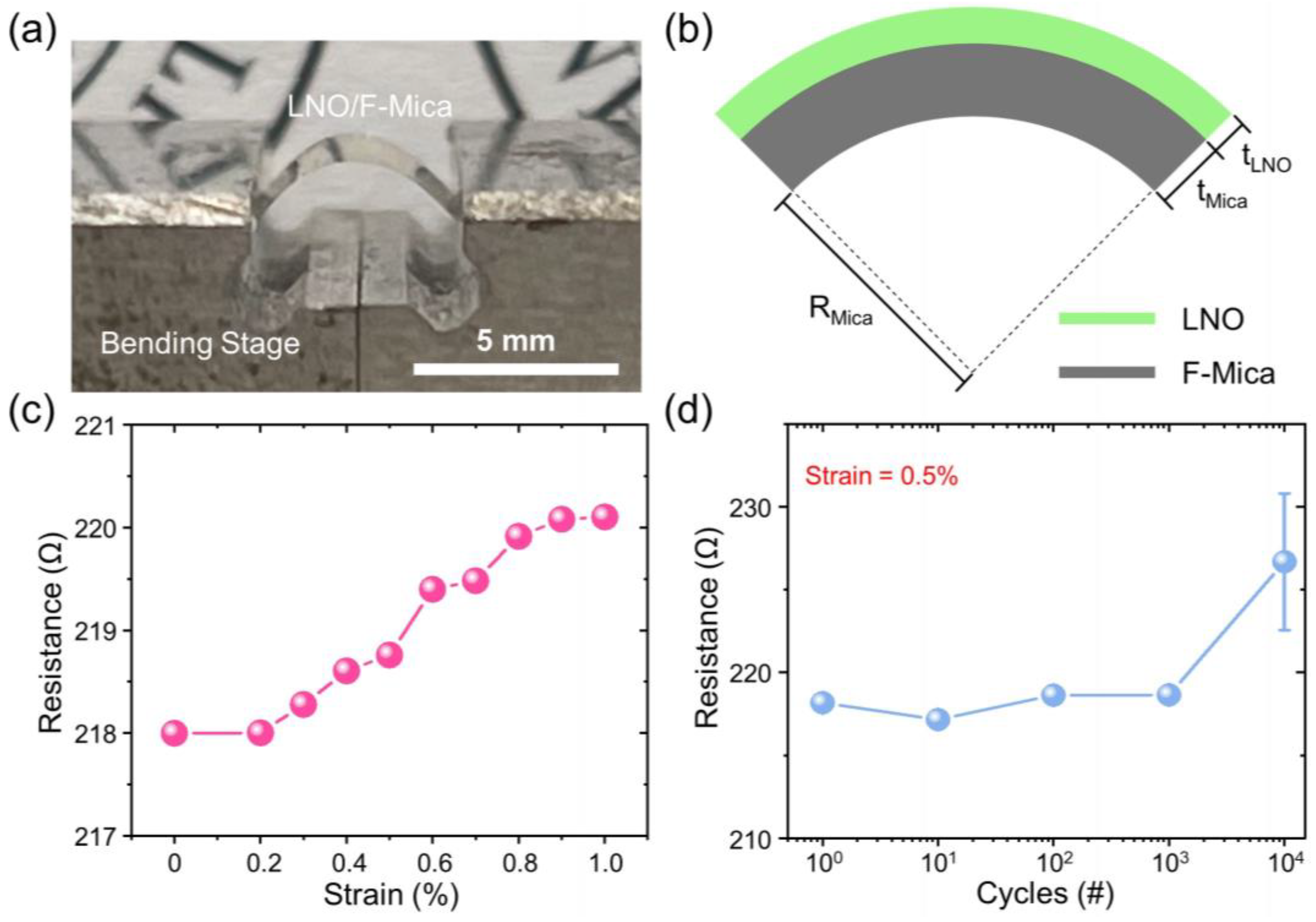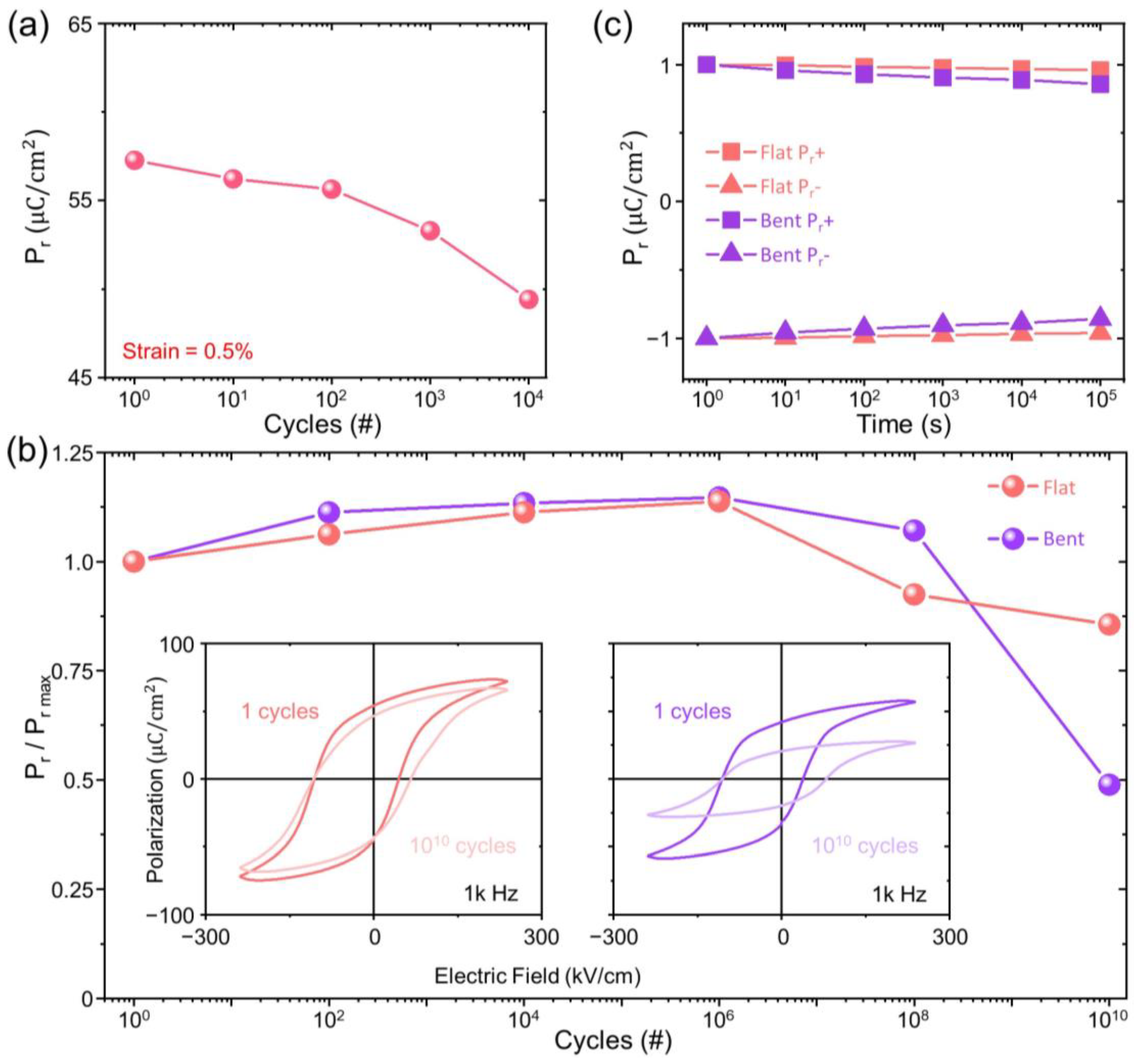Optimization of a LaNiO3 Bottom Electrode for Flexible Pb(Zr,Ti)O3 Film-Based Ferroelectric Random Access Memory Applications
Abstract
:1. Introduction
2. Experimental Details
2.1. Reagents
2.2. Film Fabrication
2.3. Characterization
3. Results and Discussion
4. Summary
Supplementary Materials
Author Contributions
Funding
Data Availability Statement
Conflicts of Interest
References
- Jaffe, B.; Cook, W.R., Jr.; Jaffe, H. Piezoelectric Ceramics; Academic Press: London, UK, 1971. [Google Scholar]
- Xu, Y. Ferroelectric Materials and Their Applications; North-Holland: Amsterdam, The Netherlands, 1991. [Google Scholar]
- Kumar, A.; Chand, P. Pyroelectric Materials: Physics and Applications; Wiley-VCH: Weinheim, Germany, 2023. [Google Scholar]
- Miyasako, T.; Senoo, M.; Tokumitsu, E. Ferroelectric-gate thin-film transistors using indium-tin-oxide channel with large charge controllability. Appl. Phys. Lett. 2005, 86, 162902. [Google Scholar] [CrossRef]
- Muralt, P. Ferroelectric thin films for micro-sensors and actuators: A review. J. Micromech. Microeng. 2000, 10, 136–146. [Google Scholar] [CrossRef]
- Jung, J.H.; Lee, M.; Hong, J.-I.; Ding, Y.; Chen, C.-Y.; Chou, L.-J.; Wang, Z.L. Lead-free NaNbO3 nanowires for a high output piezoelectric nanogenerator. ACS Nano 2011, 5, 10041–10046. [Google Scholar] [CrossRef]
- Uchino, K. Ferroelectric Device; CRC Press: New York, NY, USA, 2009. [Google Scholar]
- Yamamoto, Y.; Harada, S.; Yamamoto, D.; Honda, W.; Arie, T.; Akita, S.; Takei, K. Printed multifunctional flexible device with an integrated motion sensor for health care monitoring. Sci. Adv. 2016, 2, e1601473. [Google Scholar] [CrossRef]
- Gao, W.; Emaminejad, S.; Nyein, H.Y.Y.; Challa, S.; Chen, K.; Peck, A.; Fahad, H.M.; Ota, H.; Shiraki, H.; Kiriya, D.; et al. Fully integrated wearable sensor arrays for multiplexed in situ perspiration analysis. Nature 2016, 529, 509–514. [Google Scholar] [CrossRef]
- Yang, J.C.; Mun, J.; Kwon, S.Y.; Park, S.; Bao, Z.; Park, S. Electronic skin: Recent progress and future prospects for skin-attachable devices for health monitoring, robotics, and prosthetics. Adv. Mater. 2019, 31, 1904765. [Google Scholar] [CrossRef]
- Yeo, H.G.; Rahn, C.; Trolier-McKinstry, S. Efficient Piezoelectric Energy Harvesters Utilizing (001) Textured Bimorph PZT Films on Flexible Metal Foils. Adv. Funct. Mater. 2016, 26, 5940–5946. [Google Scholar] [CrossRef]
- Ko, Y.J.; Kim, D.Y.; Won, S.S.; Ahn, C.W.; Kim, I.W.; Kingon, A.I.; Kim, S.-H.; Ko, J.-H.; Jung, J.H. Flexible Pb(Zr0.52Ti0.48)O3 films for a hybrid piezoelectric-pyroelectric nanogenerator under harsh environments. ACS Appl. Mater. Interfaces 2016, 8, 6504–6511. [Google Scholar] [CrossRef]
- Bitla, Y.; Chu, Y.H. MICAtronics: A new platform for flexible X-tronics. FlatChem 2017, 3, 26–42. [Google Scholar] [CrossRef]
- Lu, D.; Baek, D.J.; Hong, S.S.; Kourkoutis, L.F.; Hikita, Y.; Hwang, H.Y. Synthesis of freestanding single-crystal perovskite films and heterostructures by etching of sacrificial water-soluble layers. Nat. Mater. 2016, 15, 1255–1260. [Google Scholar] [CrossRef]
- An, F.; Qu, K.; Zhong, G.; Dong, Y.; Ming, W.; Zi, M.; Liu, Z.; Wang, Y.; Qi, B.; Ding, Z.; et al. Highly flexible and twistable freestanding single crystalline magnetite film with robust magnetism. Adv. Funct. Mater. 2020, 30, 2003495. [Google Scholar] [CrossRef]
- Kum, H.S.; Lee, H.; Kim, S.; Lindemann, S.; Kong, W.; Qiao, K.; Chen, P.; Irwin, J.; Lee, J.H.; Xie, S.; et al. Heterogeneous integration of single-crystalline complex-oxide membranes. Nature 2020, 578, 75–81. [Google Scholar] [CrossRef]
- Huang, J.; Chen, W. Flexible strategy of epitaxial oxide thin films. iScience 2022, 25, 105041. [Google Scholar] [CrossRef]
- Kingon, A.I.; Shinivasan, S. Lead zirconate titanate thin films directly on copper electrodes for ferroelectric, dielectric, and piezoelectric applications. Nat. Mater. 2005, 4, 233–237. [Google Scholar] [CrossRef]
- Jiang, J.; Bitla, Y.; Huang, C.-W.; Do, T.H.; Liu, H.-J.; Hsieh, Y.-H.; Ma, C.-H.; Jang, C.-Y.; Lai, Y.-H.; Chiu, P.-W.; et al. Flexible ferroelectric element based on van der Waals heteroepitaxy. Sci. Adv. 2017, 3, e1700121. [Google Scholar] [CrossRef]
- Xu, X.; Su, C.; Shao, Z. Fundamental Understanding and Application of Ba0.5Sr0.5Co0.8Fe0.2O3−δ Perovskite in Energy Storage and Conversion: Past, Present, and Future. Energy Fuels 2021, 35, 13585–13609. [Google Scholar] [CrossRef]
- He, J.; Xu, X.; Li, M.; Zhou, S.; Zhou, W. Recent advances in perovskite oxides for non-enzymatic electrochemical sensors: A review. Anal. Chim. Acta 2023, 1251, 341007. [Google Scholar]
- Sun, H.; Kim, H.; Xu, X.; Fei, L.; Jung, W.C.; Shao, Z. Thin Films Fabricated by Pulsed Laser Deposition for Electrocataly-sis. Renewables 2023, 1, 21–38. [Google Scholar] [CrossRef]
- Chopra, A.; Bayraktar, M.; Nijland, M.; Elshof, J.E.; Bijkerk, F.; Rijnders, G. Tuning of large piezoelectric response in nanosheet-buffered lead zirconate titanate films on glass substrates. Sci. Rep. 2017, 7, 251. [Google Scholar] [CrossRef]
- Guo, H.; Li, Z.W.; Zhao, L.; Hu, Z.; Chang, C.F.; Kuo, C.-Y.; Schmidt, W.; Piovano, A.; Pi, T.W.; Sobolev, O.; et al. Antiferromagnetic correlations in the metallic strongly correlated transition metal oxide LaNiO3. Nat. Commun. 2018, 9, 43. [Google Scholar] [CrossRef]
- Patterson, A.L. The Scherrer formula for X-ray particle size determination. Phys. Rev. 1939, 56, 978. [Google Scholar] [CrossRef]
- Scherwitzl, R.; Gariglio, S.; Zubko, P.; Gibert, M.; Triscone, J.-M. Metal-insulator transition in ultra thin LaNiO3 films. Phys. Rev. Lett. 2011, 106, 246403. [Google Scholar] [CrossRef]
- Kumar, Y.; Bhatt, H.; Prajapat, C.L.; Poswal, H.K.; Basu, S.; Singh, S. Effect of structural disorder on transport properties of LaNiO3 thin films. J. Appl. Phys. 2018, 124, 065302. [Google Scholar] [CrossRef]
- Oh, K.L.; Kwak, Y.M.; Kong, D.S.; Ryu, S.; Kim, H.; Jeen, H.; Choi, S.; Jung, J.H. Mechanical stability of ferrimagnetic CoFe2O4 flexible thin films. Curr. Appl. Phys. 2021, 31, 87–92. [Google Scholar] [CrossRef]
- Chen, J.; Teo, E.H.T.; Yao, K. Electromechanical Actuators for Haptic Feedback with Fingertip Contact. Actuators 2023, 12, 104. [Google Scholar] [CrossRef]
- Peddigari, M.; Wang, B.; Wang, R.; Yoon, W.-H.; Jang, J.; Lee, H.; Song, K.; Hwang, G.-T.; Wang, K.; Hou, Y.; et al. Giant energy density via mechanically tailored relaxor ferroelectric behavior of PZT thick film. Adv. Mater. 2023, 35, 2302554. [Google Scholar] [CrossRef]
- Wang, Y.; Ouyang, J.; Cheng, H.; Shi, Y.; Nishikado, T.; Kanno, I. High performance LaNiO3-buffered, (001)-oriented PZT piezoelectric films integrated on (111) Si. Appl. Phys. Lett. 2022, 121, 182902. [Google Scholar] [CrossRef]
- Chae, B.G.; Yang, Y.S.; Lee, S.H.; Jang, M.S.; Lee, S.J.; Kim, S.H.; Baek, W.S.; Kwon, S.C. Comparative analysis for the crystalline and ferroelectric properties of Pb(Zr,Ti)O3 thin films deposited on metallic LaNiO3 and Pt electrodes. Thin Solid Films 2002, 410, 107–113. [Google Scholar] [CrossRef]
- Liu, J.S.; Zhang, S.R.; Zeng, H.Z.; Yang, C.T.; Yuan, Y. Coercive field dependence of the grain size of ferroelectric films. Phys. Rev. B 2005, 72, 172101. [Google Scholar] [CrossRef]
- Wang, G.S.; Remiens, D.; Soyer, C. Combined annealing temperature and thickness effects on properties of PbZr0.53Ti0.47O3 films on LaNiO3/Si substrate by sol–gel process. J. Cryst. Growth 2006, 293, 370–375. [Google Scholar] [CrossRef]
- Ghoneim, M.T.; Hussain, M.M. Study of harsh environment operation of flexible ferroelectric memory integrated with PZT and silicon fabric. Appl. Phys. Lett. 2015, 107, 052904. [Google Scholar] [CrossRef]
- Fengler, F.P.G.; Pešić, M.; Starschich, S.; Schneller, T.; Künneth, C.; Böttger, U.; Mulaosmanovic, H.; Schenk, T.; Park, M.H.; Nigon, R.; et al. Domain pinning: Comparison of hafnia and PZT based ferroelectrics. Adv. Electron. Mater. 2017, 3, 1600505. [Google Scholar] [CrossRef]
- Dunn, S.; Whatmore, R.W. Substrate effects on domain structures of PZT 30/70 sol-gel films via PiezoAFM. J. Eur. Ceram. Soc. 2002, 22, 825–833. [Google Scholar] [CrossRef]




| Crystallization Temperature (°C) | FWHM (deg.) | Grain Size (nm) | Surface Roughness (nm) | Resistivity (Ω cm) |
|---|---|---|---|---|
| 600 | 1.09 | 7.9 | 0.9 | 39.7 |
| 700 | 0.92 | 9.2 | 0.9 | 7.2 × 10−3 |
| 800 | 0.84 | 10.2 | 1.7 | 3.3 × 10−3 |
| 900 | 0.87 | 9.9 | 2.8 | 5.4 × 10−3 |
| Thickness (nm) | Resistivity at Room Temperature (Ω cm) | ||
|---|---|---|---|
| 600 °C | 700 °C | 800 °C | |
| 20 | >5 M | 48.7 | 24.4 × 10−3 |
| 40 | >5 MΩ | 46.6 | 23.9 × 10−3 |
| 60 | >5 MΩ | 23.4 × 10−3 | 10.2 × 10−3 |
| 80 | 42 Ω | 8.0 × 10−3 | 4.2 × 10−3 |
| 100 | 41.3 Ω | 7.6 × 10−3 | 3.9 × 10−3 |
| 120 | 39.7 Ω | 7.2 × 10−3 | 3.3 × 10−3 |
| LNO Thickness (nm) | Remnant Polarization (μC/cm2) | Dielectric Constant at 1 kHz | Dielectric Loss at 1 kHz |
|---|---|---|---|
| 80 | 45.2 | 668 | 0.089 |
| 100 | 53.7 | 661 | 0.081 |
| 120 | 57.1 | 746 | 0.067 |
| Fatigue | Remnant Polarization (μC/cm2) | |
|---|---|---|
| Initial | Final | |
| Flat | 57.1 | 46.5 |
| Bent | 41.9 | 20.5 |
| Retention | Remnant Polarization (μC/cm2) | |
|---|---|---|
| Initial | Final | |
| Flat | 57.1 | 52.2 |
| Bent | 41.9 | 36.0 |
Disclaimer/Publisher’s Note: The statements, opinions and data contained in all publications are solely those of the individual author(s) and contributor(s) and not of MDPI and/or the editor(s). MDPI and/or the editor(s) disclaim responsibility for any injury to people or property resulting from any ideas, methods, instructions or products referred to in the content. |
© 2023 by the authors. Licensee MDPI, Basel, Switzerland. This article is an open access article distributed under the terms and conditions of the Creative Commons Attribution (CC BY) license (https://creativecommons.org/licenses/by/4.0/).
Share and Cite
Choi, Y.U.; Ahn, H.S.; Hong, J.E.; Yang, D.I.; Lee, H.-P.; Jeong, D.-Y.; Lee, M.; Kim, J.H.; Jung, J.H. Optimization of a LaNiO3 Bottom Electrode for Flexible Pb(Zr,Ti)O3 Film-Based Ferroelectric Random Access Memory Applications. Crystals 2023, 13, 1613. https://doi.org/10.3390/cryst13121613
Choi YU, Ahn HS, Hong JE, Yang DI, Lee H-P, Jeong D-Y, Lee M, Kim JH, Jung JH. Optimization of a LaNiO3 Bottom Electrode for Flexible Pb(Zr,Ti)O3 Film-Based Ferroelectric Random Access Memory Applications. Crystals. 2023; 13(12):1613. https://doi.org/10.3390/cryst13121613
Chicago/Turabian StyleChoi, Yeong Uk, Hyun Soo Ahn, Jung Ehy Hong, Dong In Yang, Hwa-Pyeong Lee, Dae-Yong Jeong, Minbaek Lee, Jong Hun Kim, and Jong Hoon Jung. 2023. "Optimization of a LaNiO3 Bottom Electrode for Flexible Pb(Zr,Ti)O3 Film-Based Ferroelectric Random Access Memory Applications" Crystals 13, no. 12: 1613. https://doi.org/10.3390/cryst13121613
APA StyleChoi, Y. U., Ahn, H. S., Hong, J. E., Yang, D. I., Lee, H.-P., Jeong, D.-Y., Lee, M., Kim, J. H., & Jung, J. H. (2023). Optimization of a LaNiO3 Bottom Electrode for Flexible Pb(Zr,Ti)O3 Film-Based Ferroelectric Random Access Memory Applications. Crystals, 13(12), 1613. https://doi.org/10.3390/cryst13121613








